Research on Interrupted Sampling Repeater Jamming Performance Based on Joint Frequency Shift/Phase Modulation
Abstract
:1. Introduction
- Its time–frequency (TF) distribution is the same within an interrupted sampling period, and the distribution characteristics are discontinuous.
- The pulse compression results have a strong distribution regularity for different signals. A set of false target strings are generated for the LFM signal, and the multi-order false target is centered on the zero-order false target, showing a symmetrical attenuation distribution on both sides. The amplitude decays rapidly with the increase in the order. There is only one lagging false target for the phase-coded signal.
- The jamming amplitude is limited and proportional to the duty cycle. The attenuation speed of multi-order false target amplitude is proportional to the duty cycle for the LFM signals.
- The zero-order false target lags behind the real target by at least one interrupted sampling pulse width. The smaller the interrupted sampling pulse width, the smaller the distance between the zero-order false target and the real target, and vice versa. Therefore, when the interrupted sampling pulse width is small, the detection probability of the real target can be enhanced in one range cell. When the interrupted sampling pulse width is large, the lag time of the zero-order target is longer, which may expose the real target.
- For LFM signals, joint modulation solves the problem of the same time–frequency distribution within an interrupted sampling period and destroys the distribution law of the pulse compression result. The coherent superposition of jamming signals is achieved by controlling the frequency shift matrix and phase modulation parameters. The strong false target or interference area is formed before the real target.
- For the phase-coded signals, the frequency shift modulation is reduced, and the pre-lead false target is generated using code sequence prediction and two-phase modulation. In addition, the sidelobe is similar to the noise interference, and the interference range is increased.
2. The Principle of ISRJ
2.1. ISRJ
2.2. Analysis of ISRJ Parameters for LFM Signals
2.3. Analysis of ISRJ Parameters for Phase-Coded Signals
3. Frequency Shift and Phase Modulation Characteristics of ISRJ
3.1. Frequency Shift and Phase Modulation Characteristics of ISRJ for LFM Signals
3.1.1. Frequency Shift Modulatin Characteristics
3.1.2. Phase Modulation Characteristics
- (1)
- The phase modulation code sequence width mainly affects , , the effective false target amplitude, and interference range. However, the influence of on the false target amplitude and the interference range are mutually restricted. Therefore, to increase the phase modulation effect, the influence of on the interference amplitude should be reduced as much as possible. The weight of should be increased in the amplitude adjustment.
- (2)
- The additional phase affects , which works through the relationship between the additional phases, and the effect is complex.
3.2. Frequency Shift and Phase Modulation Characteristics of ISRJ for Phase-Coded Signals
3.2.1. Frequency Shift Modulation Characteristics
3.2.2. Phase Modulation Characteristics
4. ISRJ Based on Joint Frequency Shift/Phase Modulation
4.1. No Phase Jump in the Code Sequence Segmented Frequency Shift Slice
4.2. Phase Jump in the Code Sequence Segmented Frequency Shift Slice
5. Simulation
5.1. Frequency Shift and Phase Modulation Characteristics of ISRJ
5.2. Frequency Shift/Phase Joint Modulation Characteristics of ISRJ
5.3. Comparative Analysis of the Modulation Methods in This Paper and Other Modulation Methods
6. Conclusions
Author Contributions
Funding
Institutional Review Board Statement
Informed Consent Statement
Data Availability Statement
Conflicts of Interest
References
- Roome, S.J. Digital radio frequency memory. Electron. Commun. Eng. J. 1990, 2, 147–153. [Google Scholar] [CrossRef]
- Berger, S.D. Digital radio frequency memory linear range gate stealer spectrum. IEEE Trans. Aerosp. Electron. Syst. 2003, 39, 725–735. [Google Scholar] [CrossRef]
- Wang, X.; Liu, J.; Zhang, W.; Fu, Q.; Liu, Z.; Xie, X. Mathematic principles of interrupted-sampling repeater jamming (ISRJ). Sci. China Ser. Inf. Sci. 2007, 50, 113–123. [Google Scholar] [CrossRef]
- Feng, D.; Tao, H.; Yang, Y.; Liu, Z. Jamming de-chirping radar using interrupted-sampling repeater. Sci. China Inf. Sci. 2011, 54, 2138–2146. [Google Scholar] [CrossRef]
- Feng, D.; Xu, L.; Pan, X.; Wang, X. Jamming wideband radar using interrupted-sampling repeater. IEEE Trans. Aerosp. Electron. Syst. 2017, 53, 1341–1354. [Google Scholar] [CrossRef]
- Ji, L.; Hua, W.; Wei, W. Analysis of Intermittent-Sampling Repeater Jamming Against Multi-Carrier Phase Coded Radar. Signal Process. 2019, 35, 49–56. [Google Scholar]
- Shi, F.Q.; Zhou, C.; Liu, Q.H. Characteristics Analysis of Interrupted-Sampling Repeater Jamming. Signal Process. 2017, 33, 1616–1624. [Google Scholar]
- Shen, R.; Liu, Z.; Sui, J.; Wei, X. Study on interrupted-sampling repeater jamming performance based on intra-pulse frequency coded signal. In Proceedings of the Ninth International Conference on Digital Image Processing (ICDIP 2017), Hong Kong, China, 19–22 May 2017; Volume 10420, pp. 1012–1016. [Google Scholar]
- Wu, X.F.; Bai, Z.G.; Dai, D.H.; Wang, X.S. Azimuth intermittent sampling repeater jamming to SAR. Signal Process. 2010, 26, 1–6. [Google Scholar]
- Gong, S.; Wei, X.; Li, X. ECCM scheme against interrupted sampling repeater jammer based on time-frequency analysis. J. Syst. Eng. Electron. 2014, 25, 996–1003. [Google Scholar] [CrossRef]
- Zhou, C.; Wang, C.; Gong, J.; Tan, M. Research on ISRJ interference suppression method based on time domain filter. In Proceedings of the 2022 International Conference on Optoelectronic Information and Functional Materials (OIFM 2022), Chongqing, China, 18–20 March 2022; Volume 12255, pp. 27–32. [Google Scholar]
- Wu, W.; Zou, J.; Chen, J.; Xu, S.; Chen, Z. False-target recognition against interrupted-sampling repeater jamming based on integration decomposition. IEEE Trans. Aerosp. Electron. Syst. 2021, 57, 2979–2991. [Google Scholar] [CrossRef]
- Zhou, K.; Li, D.; Su, Y.; Liu, T. Joint design of transmit waveform and mismatch filter in the presence of interrupted sampling repeater jamming. IEEE Signal Process. Lett. 2020, 27, 1610–1614. [Google Scholar] [CrossRef]
- Lu, L.; Gao, M. An Improved Sliding Matched Filter Method for Interrupted Sampling Repeater Jamming Suppression Based on Jamming Reconstruction. IEEE Sens. J. 2022, 22, 9675–9684. [Google Scholar] [CrossRef]
- Wei, Z.; Liu, Z.; Peng, B.; Shen, R. ECCM scheme against interrupted sampling repeater jammer based on parameter-adjusted waveform design. Sensors 2018, 18, 1141. [Google Scholar] [CrossRef] [Green Version]
- Liu, Z.; Zhang, Q.; Li, K. An Anti-Jamming Method against Two-Dimensional Deception Jamming by Spatial Location Feature Recognition. Sensors 2021, 21, 7702. [Google Scholar] [CrossRef] [PubMed]
- Hanbali, S.B.S. Technique to counter improved active echo cancellation based on ISRJ with frequency shifting. IEEE Sens. J. 2019, 19, 9194–9199. [Google Scholar] [CrossRef]
- Wu, Q.; Liu, J.; Wang, J.; Zhao, F.; Xiao, S. Improved active echo cancellation against synthetic aperture radar based on nonperiodic interrupted sampling modulation. IEEE Sens. J. 2018, 18, 4453–4461. [Google Scholar] [CrossRef]
- Wu, Q. Study on Approaches and Applications of Interrupted Sampling Modulation on Wideband Radar Signals. Ph.D. Dissertation, National University of Defense Technology, Changsha, China, 2019. [Google Scholar]
- Zhang, Y.R.; Li, Y.J.; Li, M.L.; Gao, M.G.; Fu, X.J. Suppress jamming technique of multiple false targets on interrupted-sampling and non-uniform periodic repeater. Acta Electonica Sin. 2016, 44, 46. [Google Scholar]
- Zhou, P.; Zeng, Q.; Luo, Y. Intermittent Sampling Repeater Jamming Technique Based on Multi-waveform Modulation. Mod. Radar 2020, 42, 77–83. [Google Scholar]
- Liu, J.C.; Wang, X.S.; Liu, Z.; Yang, J.H.; Wang, G.Y. Preceded false target groups jamming against LFM pulse compression radars. Electron. Inf. Technol. 2008, 30, 1350–1353. [Google Scholar] [CrossRef]
- Liu, Y.B.; Chang, W.T.; Xu, Z.F. Study on Efficient Method of Interrupted Sampling Periodic Repeater Jamming Based on Frequency Shift. Mod. Def. Technol. 2022, 50, 85. [Google Scholar]
- Tai, N.; Pan, Y.J.; Yuan, N.C. Quasi-coherent noise jamming to LFM radar based on pseudo-random sequence phase-modulation. Radio Eng. 2015, 24, 1013–1024. [Google Scholar] [CrossRef]
- Yang, S.Q.; Tian, B. Research on Intermittent-Sampling Jamming to LFM Pulse Compression Radar Based on Phase Modulation. Comput. Integr. Manuf. Syst. 2016, 33, 9–13. [Google Scholar]
- Jiang, J.; Wang, H.; Wu, Y.; Qiu, L.; Ran, D.; Yu, D. Optimization Method for Multiple Phases Sectionalized Modulation Jamming Against Linear Frequency Modulation Radar Based on a Genetic Algorithm. IEEE Access 2020, 8, 88777–88792. [Google Scholar] [CrossRef]
- Zhang, L. Study on a New Jamming Technology against Phase-Coded Radar. Ph.D. Dissertation, National University of Defense Technology, Changsha, China, 2008. [Google Scholar]
- Zhang, P.; Wang, J.; Fang, M. Analysis of intermittent-sampling repeater jamming against phase-coded radar. Mod. Def. Technol. 2015, 43, 192–198. [Google Scholar]
- Luo, Z.; Li, J.; Dong, X.; Sun, J. Research on Non-uniform Interrupted Sampling Repeater Jamming for Phase Coded Radar. J. Phys. Conf. Ser. 2022, 2209, 012004. [Google Scholar] [CrossRef]
- Xu, L.T.; Feng, D.J.; Zhao, J.; Zhang, W.M. Preceded False Targets Jamming Against Phase Coded Radars. J. Astronaut. 2013, 34, 133–138. [Google Scholar]
- Zhang, P.; Wang, J. Jamming technique of intermittent-sampling predictive repeater based on DRFM. Syst. Eng. Electron. 2015, 37, 795–801. [Google Scholar]
- Lu, Y.; Zhang, S.; Guo, H. A Study on Jamming Time Sequence Based on Interrupted Sampling with Time-delay Superposition. Modern Radar. 2020, 42, 52–56. [Google Scholar]
- Wang, J.; Zhang, P. Multi-carrier Modulation Repeater Jamming against Linear Frequency Modulated Pulse-compression Radar. Electron. Inf. Technol. 2015, 37, 2727–2734. [Google Scholar]
- Xu, P.; Wang, Z.H.; Liu, D.Q. Non-Uniform Repeater Repeating Jamming Patterns Based on Shift Frequency Modulation. Mod. Def. Technol. 2019, 47, 113–120. [Google Scholar]


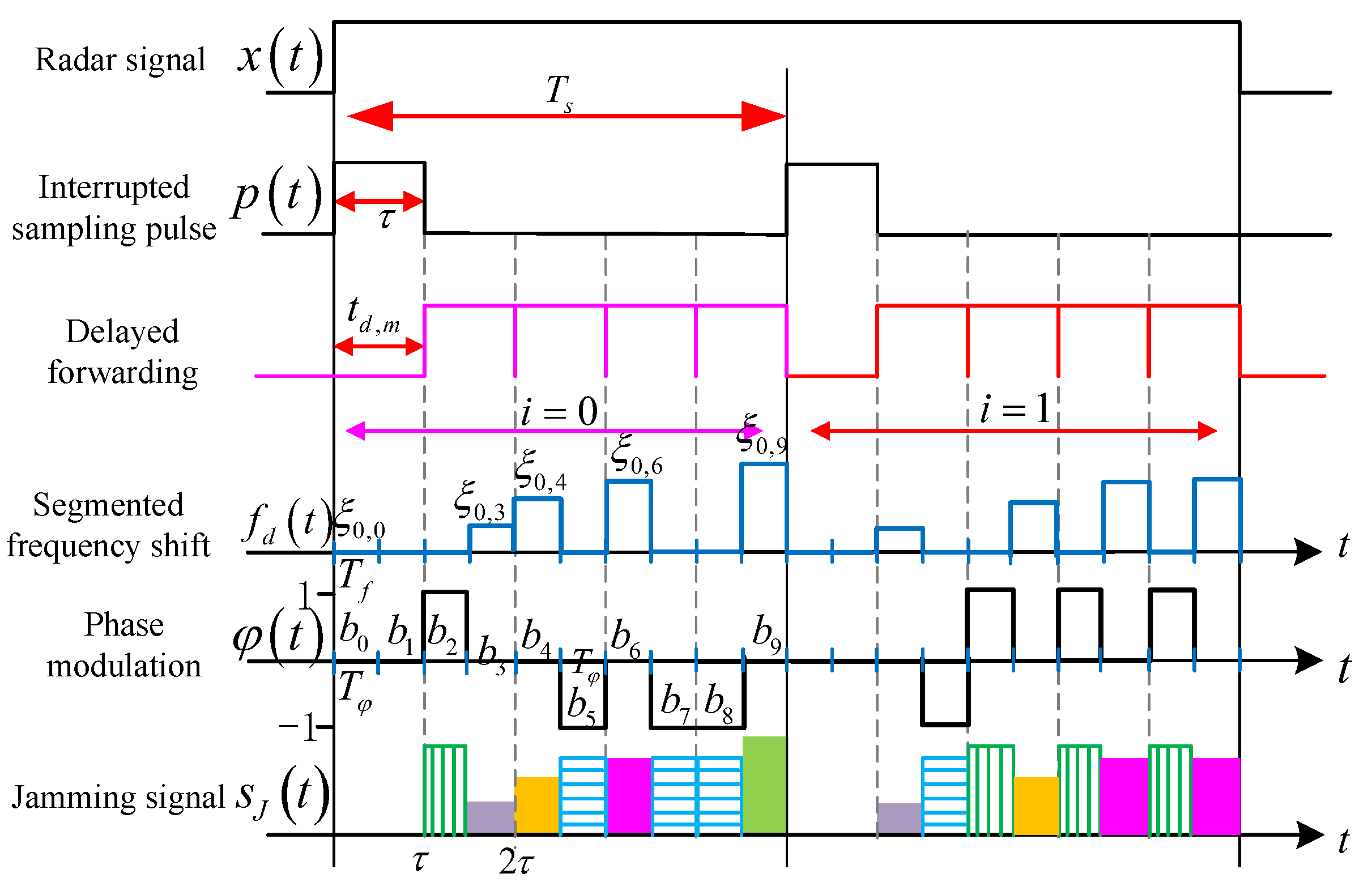


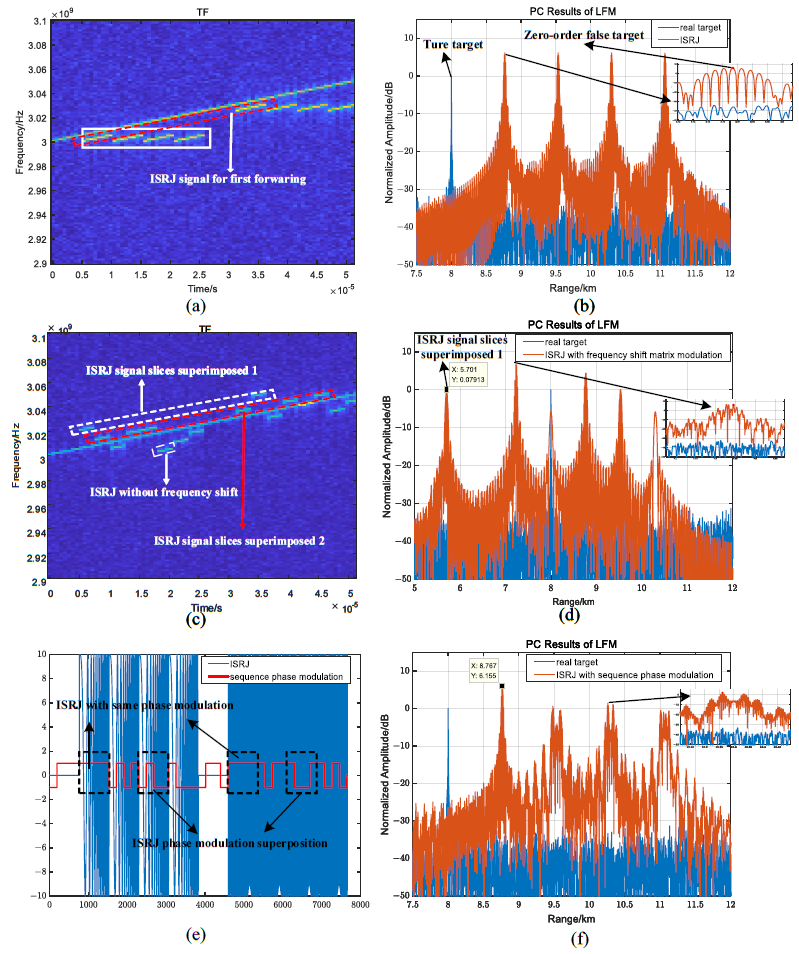
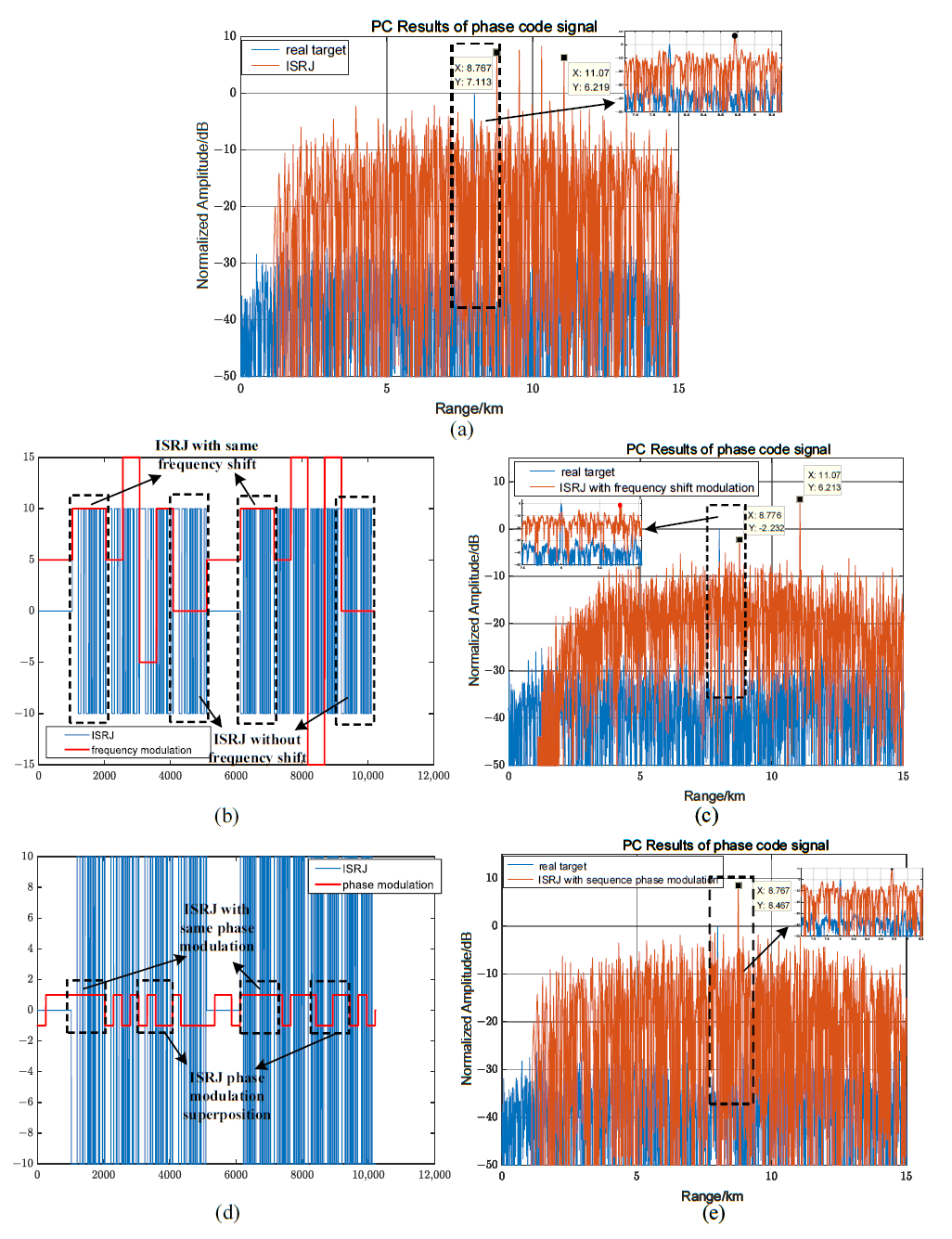
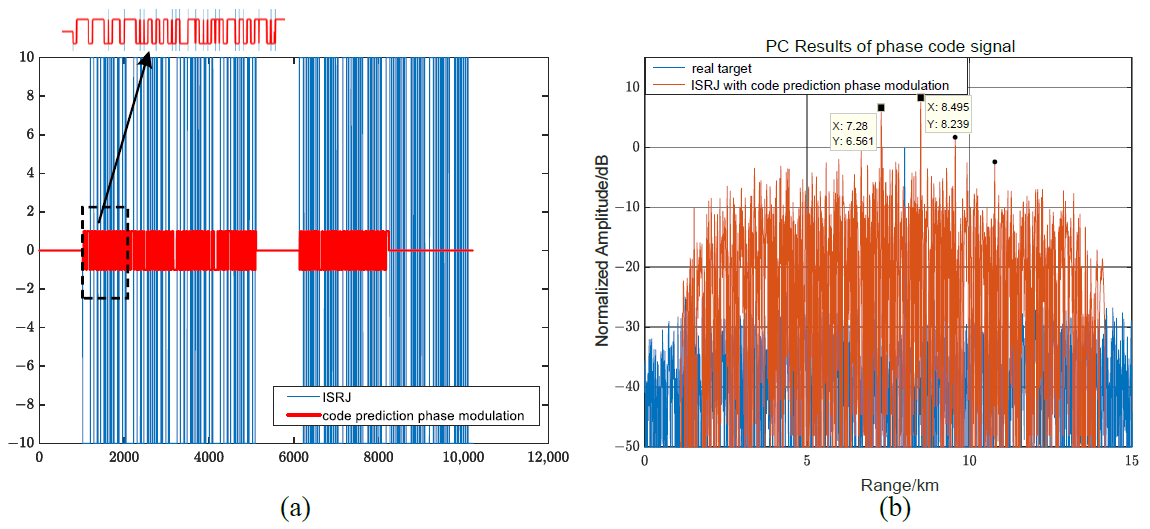
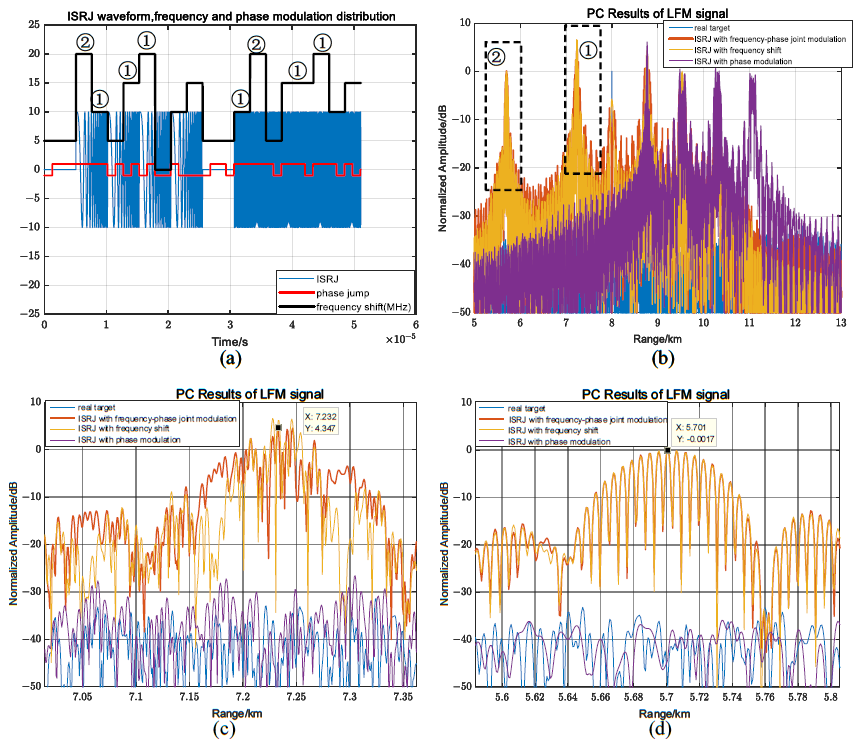


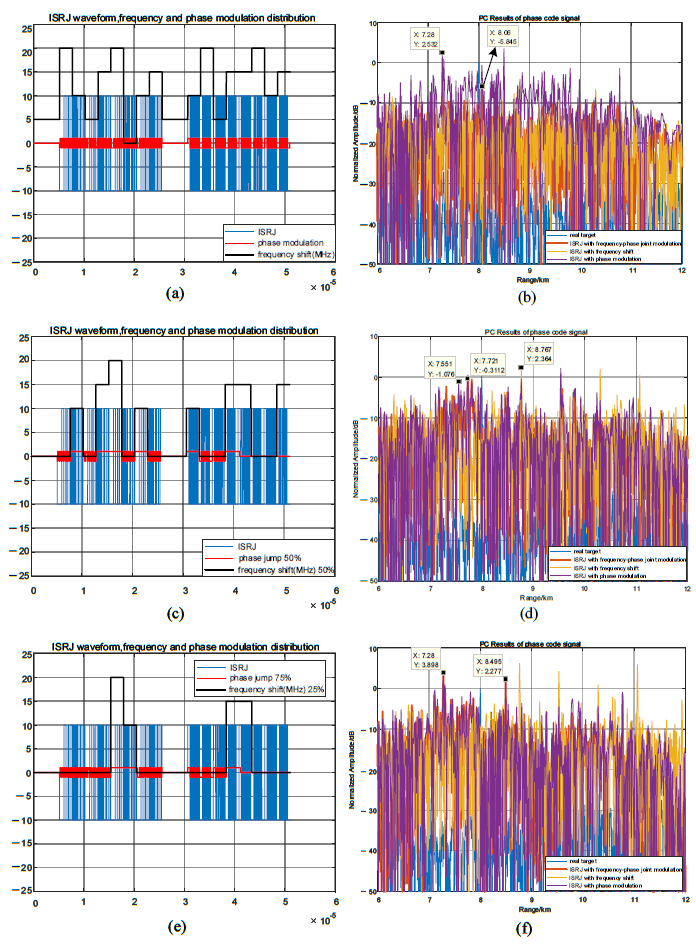
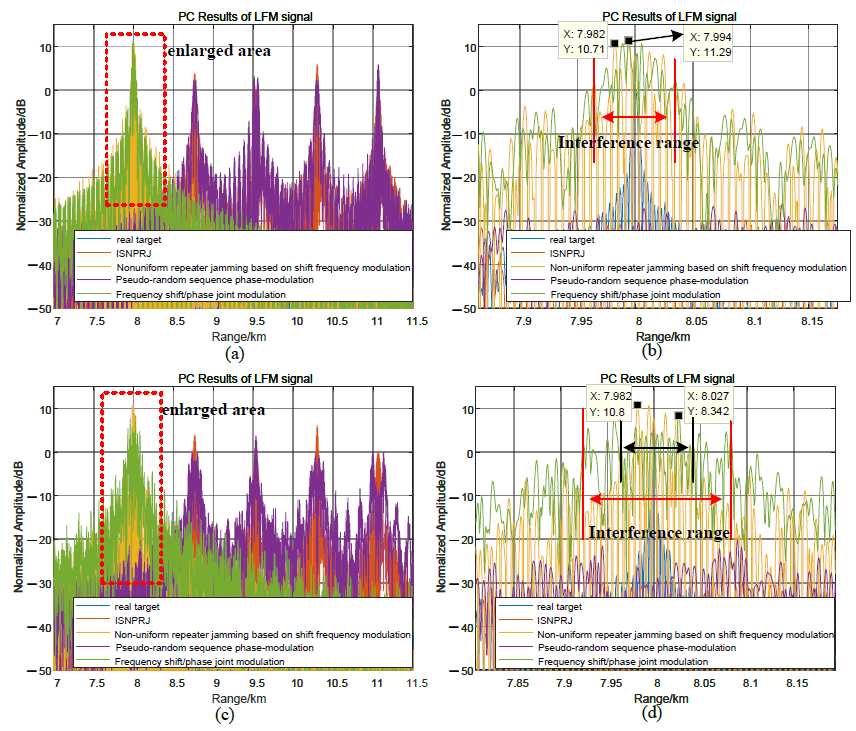

| Parameter | Symbol | Unit | Value |
|---|---|---|---|
| Signal-to-noise ratio | SNR | dB | 0 |
| Jamming-to-signal ratio | JSR | dB | 20 |
| Pulse width | μs | 51.1 | |
| Carrier frequency | GHz | 3 | |
| Sampling frequency | MHz | 200 | |
| Band | B | MHz | 50 |
| Target location | km | 8 | |
| Interrupted sampling pulse width | μs | 5.11 | |
| Interrupted sampling period | μs | 25.55 | |
| The number of interrupted sampling periods | 2 |
Disclaimer/Publisher’s Note: The statements, opinions and data contained in all publications are solely those of the individual author(s) and contributor(s) and not of MDPI and/or the editor(s). MDPI and/or the editor(s) disclaim responsibility for any injury to people or property resulting from any ideas, methods, instructions or products referred to in the content. |
© 2023 by the authors. Licensee MDPI, Basel, Switzerland. This article is an open access article distributed under the terms and conditions of the Creative Commons Attribution (CC BY) license (https://creativecommons.org/licenses/by/4.0/).
Share and Cite
Xiao, J.; Wei, X.; Sun, J. Research on Interrupted Sampling Repeater Jamming Performance Based on Joint Frequency Shift/Phase Modulation. Sensors 2023, 23, 2812. https://doi.org/10.3390/s23052812
Xiao J, Wei X, Sun J. Research on Interrupted Sampling Repeater Jamming Performance Based on Joint Frequency Shift/Phase Modulation. Sensors. 2023; 23(5):2812. https://doi.org/10.3390/s23052812
Chicago/Turabian StyleXiao, Jie, Xizhang Wei, and Jia Sun. 2023. "Research on Interrupted Sampling Repeater Jamming Performance Based on Joint Frequency Shift/Phase Modulation" Sensors 23, no. 5: 2812. https://doi.org/10.3390/s23052812





